|
World's Top Experts
Conclude Sasquatch Exists
By Bryan K. Beets
August 24, 2004
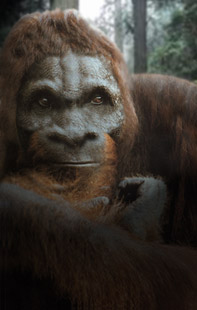 Mankind has carefully documented over 2
million species throughout the world, yet many scientists are in agreement there
might be as many as eight million species we have not yet identified. Mankind has carefully documented over 2
million species throughout the world, yet many scientists are in agreement there
might be as many as eight million species we have not yet identified.
The study of unidentified species presumed to exist without conclusive proof is
called Cryptozoology. In 1988, Professor Valentin Sapunov of Russia suggested a
new term for science called Cryptobiology defining the study of biological
objects and phenomena under deficiency of information. It is the study of enigma
within the system of scientific knowledge. His argument suggested, "The
important basis of modern biology is recurrence," suggesting low repeatability
in a phenomena doesn't necessarily indicated the absence of its existence.
Sapunov stated, "Low repeatability means impossibility to control the
phenomenon. The difference between ordinary biology and cryptobiology are the
patterns of methods," used in research.
In choosing to cover one of our most controversial articles to date, The Royal
Forum selected to examine evidence profiling the elusive and legendary Bigfoot.
We have carefully examined statistical methods, DNA testing, biological
collection, computer modeling, imprint identification, scaling, vocal analysis,
eye witness accounts, and expert opinions in search of evidence. We have
profiled the traits of the animal, collected a variety of native names, and have
researched the potential possibility of skeletal remains. We approached this
investigation with an open mind, carefully examining the facts, leads and new
ideas about the evidence.
Socrates once stated, "The knowledge of our own ignorance is the first step
toward true knowledge." In reading this topic it is important to understand we
are ourselves rationale creatures presume to have all the answers taught to us
as accepted science. Yet have we not learned that our assumptions can be wrong?
Did we not once widely presume the world was flat and that Homo sapiens where
descended from Neanderthals? In our assumption of having all the answers in
absence of mere hard evidence we find a certain security that our logic and
fundamental knowledge of our surroundings are correct. Todd Neiss, who witnessed
three Sasquatches while conducting high explosives training in the temperate
rain forest of Oregon's Coast Range, told The Royal Forum, "We as modern society
tend to only believe what we are spoon fed through our education and reading. If
it isn't taught to us then it is convenient for us not to believe." Man himself
loves to be correct in his reasoning. So often when we find the comforts of our
reasoning challenged we take a personal insult and defend our naïve notions
about our surroundings.
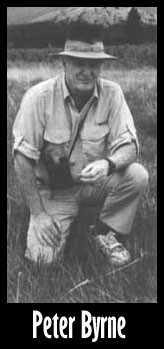 Neiss went on to say, " We have to keep an open mind and realize we haven't
found everything. Since 1990 we have found five species of deer. Peter Byrne as
recently as 1993 was challenged to find a subspecies of an elephant in Nepal
called the King Elephant by natives. They had an elephant with unusually
pronounced lobes on its forehead that pointed back to the mammoth and mastodon
days. He not only found it, but a mate to it. We are not only talking about
ants, frogs, butterflies, and small things that are still being discovered. We
are talking about huge things. Whales. There was a species of whale that had
been written off the books as being extinct that just recently was discovered
off the coast of Australia. Don’t discount that we know everything, because we
don't." Neiss went on to say, " We have to keep an open mind and realize we haven't
found everything. Since 1990 we have found five species of deer. Peter Byrne as
recently as 1993 was challenged to find a subspecies of an elephant in Nepal
called the King Elephant by natives. They had an elephant with unusually
pronounced lobes on its forehead that pointed back to the mammoth and mastodon
days. He not only found it, but a mate to it. We are not only talking about
ants, frogs, butterflies, and small things that are still being discovered. We
are talking about huge things. Whales. There was a species of whale that had
been written off the books as being extinct that just recently was discovered
off the coast of Australia. Don’t discount that we know everything, because we
don't."
Neiss has some important points. There are many animals that are continually
being discovered. For example the Coelacanth, a primitive fish thought to have
been extinct 65 million years was caught in a fishing net off the coast of
Africa in 1938. Similarly science discovered the Megamouth shark in 1976 off the
coast of Oahu, Hawaii, when it tried to eat a ship's anchor. Even an older
lineage, the Graptolites, thought to have been extinct 300 million years was
discovered in 1989. Such animals as the Platypus (1700s), Colossal Squid (1925),
Mountain Gorilla (1902), and Komodo dragon (1912) where once reported as hoaxes,
delusions, or misidentifications.
There appears to be two general genres of people of logical thought; those who
are open minded and those who feel secure in the presumption that science has
provided them with all the answers. Unfortunately the mistake in the reasoning
of the latter is that mankind is prone to make errors and science itself is
built on human reasoning. Yet in the particular subject of Bigfoot we have
historically only had circumstantial evidence that such an animal exists. There
have been almost a thousand foot print casts from around the world, several
thousands of witness reports, and a half dozen or so credible videos of Bigfoot
sightings. Every year there are more than 400 credible reports of Bigfoot in
North America alone.
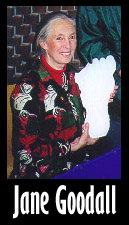 Thanks to the formal organization of societies around the world we have now
gained enormous advances in science and are applying new technology to the study
of this phenomenon. In addition, the subject is attracting the support of some
pretty big names such as Jane Goodall, made famous by her studies of chimpanzees
in Tanzania , who has been calling to legitimatize the study in the subject. In
fact, many the worlds' top experts agree there is so much evidence Bigfoot
exists that it is nearly statistically impossible to be nothing more than a
continual series of hoaxes over countless generations. Thanks to the formal organization of societies around the world we have now
gained enormous advances in science and are applying new technology to the study
of this phenomenon. In addition, the subject is attracting the support of some
pretty big names such as Jane Goodall, made famous by her studies of chimpanzees
in Tanzania , who has been calling to legitimatize the study in the subject. In
fact, many the worlds' top experts agree there is so much evidence Bigfoot
exists that it is nearly statistically impossible to be nothing more than a
continual series of hoaxes over countless generations.
 The Bigfoot Field Research Organization
www.bfro.net, one of the top organizations who has been instrumental in
research, has documented over 1,989 sightings in an extensive database going
back into the 1800s. According to the BFRO, the single state with the record for
the highest concentration of sightings is Washington with over 296 documented
cases. This is fairly easy to understand if you took a look at the state's vast
forest land and mountainous region where man rarely ventures. The Bigfoot Field Research Organization
www.bfro.net, one of the top organizations who has been instrumental in
research, has documented over 1,989 sightings in an extensive database going
back into the 1800s. According to the BFRO, the single state with the record for
the highest concentration of sightings is Washington with over 296 documented
cases. This is fairly easy to understand if you took a look at the state's vast
forest land and mountainous region where man rarely ventures.
The highest ranking states behind Washington include California with 281
sightings, Ohio with 158, Oregon with 149, and Texas with 106 cases. There is
only one state in the United States, which has never had a sighting; the
wonderful state of Hawaii.
BFRO categorizes sightings in three classes; A, B, C. Class A accounts include
accounts whereby witnesses actually see and identify the creature. Class B
encounters includes ubiquitous footprints, and all sightings where figures are
viewed at great distances, under poor lighting conditions, or any other
circumstance with a poor view. This group also consists of vocalizations. Class
C reports are defined as third party sightings.
Accounts are stored in the BFRO database and are listed in a similar format to
the report provided to us by witness Terry Reams, who experienced one of the
most credible sightings of all time. Terry told The Royal Forum the following,
"My father was driving eastbound on Interstate 84 along the Columbia River at
about 7pm; it was raining, but not torrential. It was dark. We crested a point
of the highway when we saw brake lights swerving in front of us so we slowed
thinking it must be an animal or a wreck up ahead. When we got to the area of
the braking we noticed a probable person running with arms swinging along the
divide between the two directions of travel. My first impression was that it was
someone wearing a fur type coat with a hood as I could see the wet hair. My
father was in the outside lane and there was a car in the inside lane, the car
ahead and inside slammed on the brakes as the figure crossed in front of their
car, and my father also slowed way down. At this time the figure crossed in
front of our car and my father says he felt the car hit the lower portion of the
leg and made eye to eye contact with it. At that time it started to run along
the outside lane still with the flow of traffic, at that time we came up to it's
side. I was in the passenger side of the car and looked up at this figure as we
commenced to pass. My wife was in the rear passenger window and my mother in the
center of the front seat. I looked straight into his face at about 3-4 feet, and
saw a look of total fright and terror in its eyes. At that moment, it made a 90
degree turn away from our oncoming car and right into the rear drivers side of
an oncoming pickup with a camper on it and literally bounced off the rear corner
of the camper and up about a 60 degree incline and into the trees. When I got
home I called the State Patrol and asked where I was to report an unusual
sighting, and he asked me if I thought It was a UFO, I told him no and he said a
Bigfoot, I said well something like that. He told me to call the sheriff of the
county in which it happened and I did. When I called them I went through the
same conversation. I told him the facts as I knew them. He knew I was a little
apprehensive, and told me not to feel apprehensive about turning in the sighting
as he had taken quite a few reports that night on the same sighting and four of
those where police officers. This report was taken by Peter Byrne and Barbara
Wasson with NASI. Many years later, after the sighting, I had dinner with Peter
in Portland, Oregon just before he moved to California and he told me that one
thing he was impressed with in this report was not only that so many people at
one time saw it but that two days later in the same spot but in the westbound
lane they had the same report with multiple sightings. He surmised that perhaps
the creature was returning back to the river the opposite direction as our
sighting. The creature was 6-7 feet tall, black with wet hair, not as heavy as
the so called Patterson film."
Despite many reports on the BFRO website, there are some reports like that of
Todd Neiss, Former Sergeant in the Army's 1249th Combat Engineer Battalion and
former VP of a shipping company, who has appeared on numerous shows including
Unsolved Mysteries NBC 5/94, Encounters FOX 7/94, "To The Ends of the Earth" ITV
- Britain 11/96, ”Strange But True" ITV - Britain, "Public Eye with Bryant
Gumball" CBS, Discovery Channel 11/02, and Travel Channel 04/03. Neiss is
currently wrapping up work with Blake "Buck" Eckard on a documentary four years
in the making with Stonehill Pictures.
In an interview with The Royal Forum Neiss recalled his sighting, which occurred
during 1993 on a spring day in the temperate rainforests of Oregon's Coast
Range, while conducting high-explosives training. Neiss stated, "While we were
convoying down to this staging area, I was glancing around the countryside when
I spotted across from this ravine these three jet black figures. They were
standing in the middle of the second rock quarry we blasted less than an hour
before. They stood shoulder to shoulder, one taller in the middle than the two
on either side facing us. As I am staring at them, I never took my eyes off of
them for close to 30 seconds."
Neiss described, "The one in the middle approached nine feet and stood straight
like a statue. The two that flanked it were a little shorter. The other two were
exhibiting this swaying motion. It looked like they were shifting their weight
foot to foot. I could see their arms swaying, which came down below their knees.
A human being would come no where near the size of the silhouette they
presented."
In addition to BFRO, other societies such as The Pennsylvania Bigfoot Society
have been instrumental in progress. Over five hundred sightings have been
documented Pennsylvania, of which the organization has collected and researched
over 100 since their inception. More often, organizations are deploying high
tech devices during expeditions. Eric Altman, director of the organization told
The Royal Forum, "We try all methods of field research from single person field
observation, to multi-person field observation. We have tried mobile group
movement and stationary group/individual observation both day and night. We use
audio and video recording equipment, which consists of night vision, parabolic
microphones, infrared video cameras, and infra red motion activated field
cameras." Meanwhile, organization such as BFRO seem to be using a technique
carefully placing pheromone-basted plastic chips during the day and blasting
Sasquatch calls at night. Altman went on to say, "Our year consists of numerous
day and night hikes, observations and field investigations, usually between 12
and 25 a year."
Here are a few great sites you can link into to learn more about Bigfoot:
The International Bigfoot Society
The Pennsylvania Bigfoot Society
Texas Bigfoot Research Center
The Ohio Bigfoot
Research Team
Arkansas Primate Encounter
Studies
Florida Skunk Ape
Georgia Bigfoot
Oregon Bigfoot
For centuries scientists long scoffed at the concept that a large primate could
in fact exist in North America co-existing in the remote wilderness along side
an estimated 325 million people in North America for nearly 250 years. The
population of both the United States and Canada combined totals 19,602,028
square kilometers. New statistical studies have shown there could be well in
excess of 2,000 of these creatures residing in the forests of North America.
At the lowest number, there is perhaps a single Sasquatch per every 162 thousand
people or one Bigfoot per 9,801 square kilometers (one hectometer); equivalent
to the size of the Florida Everglades. Taken into account that most of our
population lives in urban or rural farming communities, few hike or hunt, and
even fewer venture out into the forests at night. It doesn't take rocket science
to understand how a creature could evade detection. Furthermore it is believed
that Bigfoot is a nocturnal animal, often traveling in family groups up to four
in dense forests and can reach top running speeds in excess of 40 mph. Take into
account this species might perhaps possess the highest rank of intelligence,
second only to Homo sapiens, lends additional ammunition as to why it may have
been difficult to document such an animal in the past. While traveling in groups
Bigfoot can be difficult to find as there maybe only one group per 39,204 square
kilometers; the equivalent to finding a needle in many haystacks.
Despite our familiarity with the name Bigfoot, there appears to some diversity
within the species, as what would be expected from fragmented populations.
Bigfoot shares diversity just like species of deer can be found in different
parts of the world such as Mule deer, White tailed deer, Axis deer, Fallow deer,
Sika deer, or Barasingha deer.
With geographic breeding pockets located throughout the world it would only be
logical to conclude there might very well be diversity within the same species,
such as race, and perhaps in some parts of the world multiple species. Sightings
are spread throughout the world. We know of the Abominable Snowman of the
Himalayas, the Mapinguari of the Amazon, Bigfoot/Sasquatch in North America,
Yowie in Australia, The Skunk Ape of Florida, the Almas of the Altai Mountains
of Mongolia, and Yeti in Asia. Perhaps the most compelling evidence of such
diversity might exist between Sasquatch and the Florida Skunk Ape. While
Sasquatch is often reported as having human like features, a case for
inter-species diversity could be supported by some famous photos, which were
anonymously mailed to the Sarasota Sheriff's Department in Florida in the year
2000. The photos are known as the Myakka Skunk-Ape photos and bear a striking
resemblance to an Orangutan. In addition, almost all Florida sightings have been
accompanied by a strong odor, thus the name Skunk Ape, as opposed to less than
one in fifty of all Bigfoot photos in North America. Wolf Henner Fahrenbach,
Ph.D., retired researcher from the Oregon National Primate Center explains, "If
we are to assume Sasquatch invaded the North American continent in the same time
frame as modern man, then one can assume from that alone that we are dealing
with only one species, as not enough time has elapsed or the conditions have
existed for speciation beyond perhaps some racial differences. Variability among
Sasquatches is known to be high, presumably as a function of relatively low
reproductive rate and relatively high infant survival."
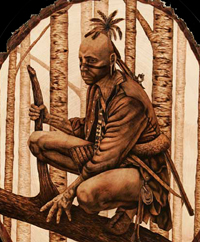 In our search of evidence, we decided to begin our search exploring historical
legends among native Americans under the assumption if Bigfoot should be real
there might be credible accounts in native American mythology. Dr. Fahrenbach
forwarded us a remarkable list of over 60 Bigfoot/Sasquatch names known to Native
Americans. In our search of evidence, we decided to begin our search exploring historical
legends among native Americans under the assumption if Bigfoot should be real
there might be credible accounts in native American mythology. Dr. Fahrenbach
forwarded us a remarkable list of over 60 Bigfoot/Sasquatch names known to Native
Americans.
Rational reasoning begins to provide evidence in and by itself. It is improbable
that a series of random hoaxes or legend could have evolved into the dialect of
over 50 tribes spread throughout the North America continent. You don't have to
be a genius to understand if Bigfoot were in fact a myth the name would be
evident in perhaps several dialects at best, but 50? Even for today's mass media
this would be an accomplishment of massive proportion. Likewise, Yeti's which
have been documented in such areas as Nepal have shown similar characteristics
and features as Sasquatch. This has occurred across the globe, on opposite sides
of earth, and in a day when there was no travel or communication between these
portions of the earth.
In North America, we are most familiar with the native name Sasquatch. Yet this
name is only one derivative of numerous names. It appears that, overtime, each
tribe assigned an individual name for something they witnessed independently.
Below we have presented the various Native American names collected by Henry
Franzoni of Oregon.
Native Names for Bigfoot Across North America
Alaska and Canada
Neginla-eh - (Alutiiq Indian/Yukon Indian) - "Wood Man"
Nantiinaq - (Native Americans from the Kenai Peninsula) - Alaska
Nant'ina - (Dena'ina Athabascan Indian) - Alaska
Urayuli - (South West Alaskan Eskimo) - Alaska
Get'qun - (Lake Iliamna Athabascan Indian) - Alaska
Kushtaka - (Southeastern Alaskan Tlingit Indian) - Alaska
Dzonoqua/Tsonaqua - (Kwakwaka'wakw Indian) "Wild Woman of the Woods"
Bukwas - (Kwakwaka'wakw Indian)- "Wild Man of the Woods."
A-hoo-la-huk - (Bristol Bay Yup'ik Indian) - Alaska
The Hairy Man - (Alaskan Athabascan Indian) - Alaska
Big Figure - (Kwakwaka'wakw Indian) [formerly the Kwakiutl]
Gilyuk - (Nelchina Plateau, south of Tyone Lake) - "Big man w/ little hat" -
Alaska
Guugiit (Haidah) "Wildman that lives in the woods" Alaska- Prince of Wales
Egeiaks - Alaska
Boqs - Bella Coola Indian
Snanaik - Bella Coola Indian
Goo-tee-khl - Tinglit/Chilkat Indian
See'atco/Kauget - (Coast Salish Indian) - "One who runs and hides"
Sacsquec, Saskehavas, Sasquatch - (Sto:lo Indian) [Coast Salish inhabiting the
upper Fraser Valley around Harrison Hot Springs, Hope, and Agassiz, Katzie (Port
Hammond), Musqueam (N. Fork of Fraser River), Cowichan and Nanaimo (Vancouver
Island)] -British Columbia.
Bushmen - (The Hare Indians) - Canada
Rugaru - (Turtle Mountain Ojibway Indian)
Windago - (Eastern Athabascan Indian)
Kitchi-sabe` (Manitoba) "The great giant or great-footed one"
Washington
Kala'litabiqw - Skagit Valley, Washington
Stick-Shower or Stick Indians - (Yakama/Klickitat/Puyallup/Puget-
Sound/Colville)
Skookum or Skoocoom - (Chinook Indian) - "Evil God of the Woods"
At'at'ahila - (Chinookan Indian)
Yi' dyi' tay - (Nehalem/Tillamook Indian) - "Wild Man"
Xi'lgo - (Nehalem/Tillamook Indian) - "Wild Woman"
Tsiatko - (Puyallup/Nisqually Indian)
Steta'l, Steetathl, Stik - (Puyallup/Nisqually Indian), Puget, Twana (Hood
Canal), Quinault (Olympics)
Zamakwas - Lummi (Boundary Bay to Anacortes), Saanich (Straits of Juan de Fuca)
Seahtik or Selatik or Seeahtkoh - (Clallam Indian)
Seat-ka - (Yakama Indian)
Ste-ye-hah-[mah] - (Yakama Indian) - "Spirit hidden under the
cover of the woods", Umatilla, Sahaptin, Molalla
Shadow Indians - (Yakama Indian)
Tah-tah-kle'-ah - (Yakama/Shasta Indian) - "Owl Woman Monster"
Qui-yihahs - (Yakama/Klickitat Indian) - "The five brothers"
Qah-lin-me - (Yakama/Klickitat Indian)
Sne-nah - (Okanogan Indian) - "Owl Women"
California
Omah, Oh-mah-'ah - (Yurok, Klamath)
Olayome - Native Americans near Clear Lake California
Plains Indians
Wetiko - (Cree Indian)
Chiye-tanka - (Lakota [western] Sioux Indian) - "big elder brother"
Chiha-tanka - (Dakota [eastern] Sioux Indian) - "big elder brother"
The Big Man - (Oglala Lakota Sioux Indian)
Ot-ne-yar-heh/Stonish Giants - Iroquois Indian
Yahyahaas - Modoc Indians
The Stone Giants/Stone Coats/Ge-no-sqwa - Seneca Indian
Miitiipi - Kawaiisu Indian
Tso-apittse - Shoshone Indian
T'oylona - Taos Indian - "person big"
Atahsaia - Zuni Indian
Big Hairy Man - (Hopi Indian)
Yanahlgloshi's - Navajo
So'yoko - Hopi Indian
Loo-poo-oi'yes - Miwuk Indian
Stone Giants - Iroquois (now known as the Haudenosaunee)
Chenoo - Abnaki, Passamaquoddy and Micmac
Atshen, Atcen - Montagnai-Naskapi and Tete-de-Boule (Cree)
Stone Giants or Dzoavits - Shoshoni
Witiko, Windigo, Wendigo - Many Algonkian Nations
Spirit/Spirit of the Woods - (Many Native American Indian Tribes)
Free-man - (Various Modern Native American Indian Tribes)
 In
our quest for an answer to the mystery we must turn to science for evidence,
since there are no actual remains or live captured specimens to conclusively
prove Sasquatch exists. W. Henner Fahrenbach, Ph.D., studied the dimensions of
706 foot print casts collected over western North America over a 40 year period.
A comprehensive report of his findings can be found
HERE In
our quest for an answer to the mystery we must turn to science for evidence,
since there are no actual remains or live captured specimens to conclusively
prove Sasquatch exists. W. Henner Fahrenbach, Ph.D., studied the dimensions of
706 foot print casts collected over western North America over a 40 year period.
A comprehensive report of his findings can be found
HERE
Dr. Fahrenbach subjected data to scaling laws appropriate to primates and
mammals
to yield height, weight, plantar pressure, gait, speed, and more from foot
length. His study provided some of the hardest evidence in support of a thriving
population yielding a mean foot length of 15.6 inches. The mean length showed
little deviation over years. More remarkable yet, the entire population of
prints generated a near perfect bell curve providing compelling evidence to
suggest a cryptic species does exist. Not only did foot length yield a bell
curve, but so did heel and ball width, which corresponded to length. If a series
of fabrications had, in fact been carried out over forty years it would
generate a distribution with many peaks rather than a bell curve.
By contrast to modern humans, an American adult male foot has a mean length of
10.4 inches and a female of 9.5 inches. The mere collection, totaling 706
different sets of foot prints over 40 years, suggests a population in the
thousands. Most experts agree the North American population ranges between 2,000
and 10,000 animals.
Dr. Fahrenbach went on to explore the overall foot width from a sample of 438
sets of prints, discovering a mean of 7.2 inches and a standard deviation of
1.69 inches. The results of his study showed foot width increased more slowly
than length, which is also common in humans. Almost the entire set of population
of prints had a greater width index than a human foot print. He also noticed
both human and Sasquatch prints get narrower with a greater length.
From a smaller sample of 123 prints, he discovered the animal possessed a heel
width with a mean of 4.38 inches. One fundamental difference appears to be that
Sasquatch rely less on the heel plant while walking bearing its weight on the
broad anterior portion of the foot, which more evenly distributes its weight
over the entire sole in the absence of an arch. This would supply more support
for their massive weight. Many documented reports and witness accounts have
reported a slapping noise while walking indicating the lack of a motion rolling
forward as in human movement.
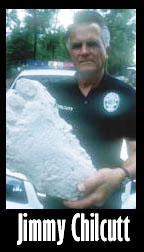 Recently, the BFRO asked Jimmy Chilcutt, Latent Fingerprint Examiner, with the
Conroe Police Department in Texas, to examine approximately 100 sets of Bigfoot
castings taken across North America over the last 20 years. Chilcutt is
considered an expert in primate finger printing and has prints on every known
primate. He explained dermal lines in Bigfoot run vertical, while those of man
are horizontal, and apes are slanted. In addition, Chilcutt found the dermal
ridges of Sasquatch to be about twice the thickness of humans. He also noticed
many prints showed variations in the splay of toes within the same set of
prints, which could not be replicated if someone strapped on plaster molds to
the bottom of their feet. In his quest for the truth, Chilcutt found scarring,
which would cause the dermal ridges to curve inward. He finally concluded the
sets of foot prints examined were authentic and that North America had a new
primate unknown to science. Recently, the BFRO asked Jimmy Chilcutt, Latent Fingerprint Examiner, with the
Conroe Police Department in Texas, to examine approximately 100 sets of Bigfoot
castings taken across North America over the last 20 years. Chilcutt is
considered an expert in primate finger printing and has prints on every known
primate. He explained dermal lines in Bigfoot run vertical, while those of man
are horizontal, and apes are slanted. In addition, Chilcutt found the dermal
ridges of Sasquatch to be about twice the thickness of humans. He also noticed
many prints showed variations in the splay of toes within the same set of
prints, which could not be replicated if someone strapped on plaster molds to
the bottom of their feet. In his quest for the truth, Chilcutt found scarring,
which would cause the dermal ridges to curve inward. He finally concluded the
sets of foot prints examined were authentic and that North America had a new
primate unknown to science.
Chilcutt isn't the only finger print expert to have studied prints. Doug Monsoon
of the Lakewood, Colorado, police department crime lab has had over 28 years in
law enforcement and after studying prints also concluded the prints he examined
were authentic. He explained how credibility was paramount to his career and the
last thing he wanted was to hang out on a limb.
 In addition to the dermal ridges, foot prints are often found depressed so far
into the ground that it would be impossible for a human to create the same
weight. For example Dr. Grover S. Krantz, physical anthropology professor at WSU,
measured prints up to 18 inches in length from heel to toe and seven inches
across at the ball and state a person would have to be eight feet tall and weigh
750 pounds to recreate the prints. In addition, he would have to wear a size 28
shoe. In addition to the dermal ridges, foot prints are often found depressed so far
into the ground that it would be impossible for a human to create the same
weight. For example Dr. Grover S. Krantz, physical anthropology professor at WSU,
measured prints up to 18 inches in length from heel to toe and seven inches
across at the ball and state a person would have to be eight feet tall and weigh
750 pounds to recreate the prints. In addition, he would have to wear a size 28
shoe.
Perhaps one of the most conclusive pieces of evidence is the famous 400 lb
plaster Skookum Cast found in Washington in 2000. It consists of an alleged
Sasquatch lower torso including a forearm, an enormous thigh, buttock, and a striking heel implant along with both dermal ridges and an print of a Achilles tendon consistent with a large primate believed not to exist. It is believed one
of the animals made the imprint in the mud, while eating berries. Dr. Jeff
Meldrum, Anthropologist and expert in primate locomotion at Idaho State
University, examined the prints along with other experts from around the
country, including Dr. Darren Swindler at Washington State University, and
concluded that the tendon and heel imprint in the cast were made by a large
primate.
 Another historical piece of evidence (tracks) occurred in 1969 near the town of
Bossburg, in northeastern Washington's Colville National Forest. What made the
tracks so important was a crippling deformity found in the right foot a type of
acquired or congenital clubfoot. The right imprint only had four toes. The
middle toe is either missing or raised above the other four. More convincing is
the deformity, which is bent radically inward from the heel. Dr. Meldrum
identified the deformity as Metatarsus Adductus, a condition of pes cavus. Most
startling was that the prints were found to have anatomical accuracy matching
the condition. Dr. Krantz calculated the natural adaptations in stride necessary
to enable a heavy animal with the deformity to walk was right on. Dr. Meldrum
found the compliant gait found in the prints reduced peak ground reaction
forces, while avoiding the concentration of weight over the heel and ball
increasing the period of double support on the opposite foot. Another historical piece of evidence (tracks) occurred in 1969 near the town of
Bossburg, in northeastern Washington's Colville National Forest. What made the
tracks so important was a crippling deformity found in the right foot a type of
acquired or congenital clubfoot. The right imprint only had four toes. The
middle toe is either missing or raised above the other four. More convincing is
the deformity, which is bent radically inward from the heel. Dr. Meldrum
identified the deformity as Metatarsus Adductus, a condition of pes cavus. Most
startling was that the prints were found to have anatomical accuracy matching
the condition. Dr. Krantz calculated the natural adaptations in stride necessary
to enable a heavy animal with the deformity to walk was right on. Dr. Meldrum
found the compliant gait found in the prints reduced peak ground reaction
forces, while avoiding the concentration of weight over the heel and ball
increasing the period of double support on the opposite foot.
In his statistical analysis, Dr. Fahrenbach examined a database of over 89
accounts whereby foot prints were measured along with visual estimations of
height. His results determined a mean imprint of 16.6 inches corresponds to a
height of 8' 1 inch. After applying a scaling formula he was able to determine a
24" footprint indicates a height of 9 feet 5 inches.
He later created a step file after examining 297 records. The step length for
the mean foot length of 15.6 inches turned out to be 5.0' even. Since transition
from walking to running occurs at around 150% of the normal step length in man,
this would indicate a walking-to-running transition in the Sasquatch of about 14
mph. The world record walking speed for humans is around 11 mph, while the top
running speed is 27 mph and the longest single jump is 30', all obviously
smaller in scale.
 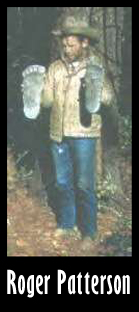 In a comprehensive analysis of the film recorded by famous Sasquatch hunters
Roger Patterson and Bob Gimlin on Oct 20, 1967, at Bluff Creek in northern
California (widely regarded as the best film footage of Bigfoot), the BFRO
applied bio-mechanical engineering and computer models to ascertain the gate of
the animal in the footage. Dr. Fahrenbach calculated The Patterson video showed
a rate of 85 steps per minute, which would be very uncomfortable for a human.
Andrew Nelson at the Center for Motion Analysis and Bio-Mechanics recreated the
stride of the animal in the Patterson film by building a 3-D virtual model of
the skeleton incorporating motion track analysis. The research concluded the
stride would have been difficult to carry out by a man and was consistent with
the upright gait associated with an early stage of evolution. Dr. Fahrenbach
explained, "its gait is a bent-knee, complaint gait and its foot has a
metatarsal hinge, features that point to an early evolutionary stage of upright
gait, one that might have evolved parallel and independently of man." In a comprehensive analysis of the film recorded by famous Sasquatch hunters
Roger Patterson and Bob Gimlin on Oct 20, 1967, at Bluff Creek in northern
California (widely regarded as the best film footage of Bigfoot), the BFRO
applied bio-mechanical engineering and computer models to ascertain the gate of
the animal in the footage. Dr. Fahrenbach calculated The Patterson video showed
a rate of 85 steps per minute, which would be very uncomfortable for a human.
Andrew Nelson at the Center for Motion Analysis and Bio-Mechanics recreated the
stride of the animal in the Patterson film by building a 3-D virtual model of
the skeleton incorporating motion track analysis. The research concluded the
stride would have been difficult to carry out by a man and was consistent with
the upright gait associated with an early stage of evolution. Dr. Fahrenbach
explained, "its gait is a bent-knee, complaint gait and its foot has a
metatarsal hinge, features that point to an early evolutionary stage of upright
gait, one that might have evolved parallel and independently of man."
Perhaps even more compelling was the scientific examination of an obvious bulge
in one of its legs indicating a rupture in the animal's quadriceps as first
indicated by Dr. Meldrum. This was later ruled to be completely impossible to
carry out with Bio-Mechanics at the time of the video.
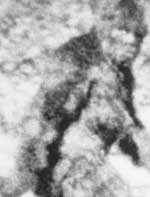 In his
studies, Dr. Fahrenbach provided an overall analysis of height, chest size, and
weight based on foot length using scaling methods based on video, witness
observation, and corresponding size of known primates. In his
studies, Dr. Fahrenbach provided an overall analysis of height, chest size, and
weight based on foot length using scaling methods based on video, witness
observation, and corresponding size of known primates.
| FOOT |
HEIGHT
|
CHEST |
WEIGHT
|
| 12" |
7'0" |
58"
|
488 lbs
|
| 15.6" |
7'10" |
65" |
658 lbs
|
| 20" |
8'8" |
72" |
854 lbs
|
| 24" |
9'5" |
77" |
1,038 lbs |
By applying scaling, Dr. Fahrenbach estimated the Bigfoot brain size up to 770
cc compared to that of a mountain Gorilla averaging 532 cc.
The smallest walking foot prints recorded ranged 4 to 5 inches, which is the
same size of human foot at one year. From print casts it is presumed the mother
is most likely the exclusive companion of a juvenile during the first few years.
Dr. Fahrenbach suggested a juvenile animal eight years of age would have a
height of approximately 6 feet. Most infants between 3 and 4 feet have been seen
with their mother, but in rare cases have also been seen by themselves.
The BFRO records no female with a small nursing infant has ever been observed.
Yet they suggest the older sibling will often stay with the mother until ten
years of age. Females reach sexual maturity at about nine years of age or at
about six feet in height. Through scaling, the average Sasquatch is estimated to
have a life span of 36 years.
To date, it has been presumed all DNA testing on stool, saliva, and hair
specimens have come up inconclusive due to their near identical human qualities.
Science can perform testing on either nuclear or mitochondrial DNA to determine
how close between human and great ape this range falls. Dr. Fahrenbach has
collected hair specimens from various states and told The Royal Forum, "Hair
color ranges a full spectrum of human natural colors, other than perhaps light
blonde. But about 60% is very dark brown to black, the rest red, brown, gray,
and quite white on occasion. I have about two dozen hair samples from various
states. All of them are congruent in internal microscopic structure, but
differing in color and length. They generally are devoid of medulla, the
cellular core of the hair, something that also is found in some human hairs and
hence, does not allow for an absolute identification. DNA analysis has been
attempted several times with negative results. In any case, the hair is not
similar to orangutan, gorilla, or chimp hair."
Meanwhile, Ray Crowe, Director of the International Bigfoot Society commented,
"Analysis from two different sources in Tennessee and North Carolina have been
collected. I have sent a sample to France myself and should have results in
October. All signs are that the creature is human. Early DNA results were
discarded as it was thought that contamination was evident. This has not been
the case though. They are very close to human."
Sasquatches are tall, averaging eight feet in height, usually have dark eyes,
walk upright on two legs, are extremely muscular, and have a combination of
facial features similar to both a human and ape, with a wide, human like nose.
They have a slanted head, which has a pronounced cone shaped top, and pronounced
forward eye-brows. Remarkably, females are noted as having breasts. Ears often
cannot be seen as they are beneath the hair, are small and close to head. Skin
on their faces, hands, and feet have been reported as distinctively human like
in appearance, yet dark and leathery. They have no visible necks, jutted chins,
and have extremely long arms said to fall below the knees. In rare instances,
both juveniles and adults have been seen on all fours. When ascending dense
slopes they frequently pull themselves up on trees with their arms. Likewise,
they have been witnessed in sitting, squatting, or lying positions and often
have worn areas in their coats from such activities. According to witness
accounts the animals are sometimes so tall they step over fences in a single
stride.
There is much evidence to suggest the animals are nocturnal. Sightings occur
about 1,500 times more at night than statistics of an even day/night
distribution would predict. Strangely, flashlights appear to make them retreat
more so than even being fired at by guns.
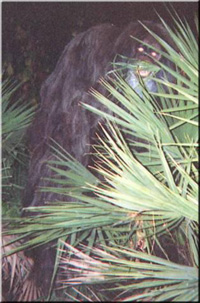 Reports indicate that, when approached at close range
Sasquatch commonly emit a
terrible odor. Hundreds of accounts have reported a smell similar to rotting
flesh, ammonia, or sulfur; strong enough to make the eye water. This is often
described as a smell unlike anything people have experienced before. Only about
one in fifty reports mention it, but are so often reported in Florida that
locals report to them as Skunk Apes. Reports indicate that, when approached at close range
Sasquatch commonly emit a
terrible odor. Hundreds of accounts have reported a smell similar to rotting
flesh, ammonia, or sulfur; strong enough to make the eye water. This is often
described as a smell unlike anything people have experienced before. Only about
one in fifty reports mention it, but are so often reported in Florida that
locals report to them as Skunk Apes.
Although still considered a right wing view, a book called, "The Scars of
Evolution" by Elaine Morgan in 1994 presented a theory that humans may have
descended from a water environment between three and seven million years ago
around the North-east African Red Sea, where bipedalism is believed to have
first formed. Around this time frame, the area evolved into a small island and
Morgan theorized the anthropoid fed at sea developing an upright gait.
In rare instances, some primates have been found swimming. For example, the
swimming Snow Monkey and the Proboscis, which lives in mangrove trees in the
swamps of Borneo have been documented swimming for miles and walking upright in
shallow water.
It has been proven there are eighteen similarities between modern man and
Oreopithecus (about ten million years old), called swamp ape, because so many of
their bones laid in mud in large numbers, including the possibility they were
bipedal.
Unlike other primates, they are powerful swimmers. On occasion they are seen on
the British Columbia coast and there have been direct observations of the
animals under water doing a frog kick. From The Royal Forum's investigation into
BFRO database of reports in the central United States it would appear the
creatures might pursue or prefer using stream-ways and rivers as possible means
of travel or hunting. In addition, it appears the creatures prefer swamps and
wetlands. Although some reports have occurred near mines, caves, and rock
quarries it is presumed they do not use them very often as there is typically
only one entrance.
BFRO investigators believe Sasquatch constructs temporary shelters referred to
as nests out of sticks and other foliage. Teepee designs are sometimes evident
and more elaborate shelters, made of partial roofs from broken or twisted tree
limbs, have been found. Often the bottoms are scattered with available
vegetation such as moss, ferns, bear grass, soft evergreen, and dead leaves to
cushion the flooring. Once discovered these shelters are abandoned. Eric Altman
of the Pennsylvania Bigfoot Society reports they have not found any nests in the
state despite numerous sightings, yet reported, "Our group discovered an area
where a large animal (unknown) bedded down in some very tall weeds. The area
measured 32 feet long by 17 feet wide."
Altman went onto to say, "Many researchers speculate they reside in caves or in
remote parts of the forest." In a later interview, Ray Crowe with the
International Bigfoot Society stated a few reports have indicated the remains of
dead animal near caves. He told The Royal Forum, "For a long time I thought
caves would not present a suitable habitat as they are cool, wet, and dark. But
more recently, I am convinced I was wrong, with the presumed occupation of lava
tubes in Idaho. In another case, a lava tube by Mt. St. Helens was found to have
several lizards skewered on sticks and left to dry." Lava tubes are often very
long caves featuring multiple or scattered openings that offer escape routes and
potential sources of water.
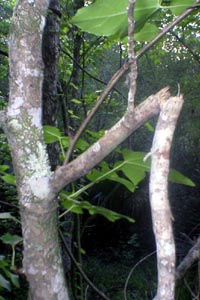 They appear to be territorial bending limbs to mark their territory. Often when
encounters happen they are reported to scare people out of their territory by
howling, tree shaking, pushing trees over, or repeatedly breaking large sticks,
while sometimes following people running alongside them. Occasionally chest
thumping has been reported although never seen. Most of this behavior is also
found in great apes. They appear to be territorial bending limbs to mark their territory. Often when
encounters happen they are reported to scare people out of their territory by
howling, tree shaking, pushing trees over, or repeatedly breaking large sticks,
while sometimes following people running alongside them. Occasionally chest
thumping has been reported although never seen. Most of this behavior is also
found in great apes.
As far as tool use, Sasquatch use branches and rocks to hit tree trunks to mark
territory or possibly to indicate position while hunting in groups. Some reports
have indicated they use sticks to kill birds or mammals. Other times they have
been reported using sticks to dig small animals out of the ground.
Sasquatch are presumed to be omnivorous occasionally feeding on meat. Their
droppings contain the remains of roots, berries, elk, deer, and various small
animals. In a study of sixty-four reports of Sasquatch carrying or eating food,
thirty-two reports mention types of meat, twenty-six mention vegetables, and one
mentions salt. Individual items mentioned reports include deer, berries, fish,
roots, sheep, cattle, corn, rabbits, garbage, clams, rodents, leaves, water
plants, oranges, grubs, and apples. When raiding fields they often leave piles
of half eaten melons or corn in nearby woods. Occasionally they have been known
to make off with calves, goats, dogs, and on occasion break into chicken coops
or rabbit hutches. They are thought to return gifts in exchange for food such as
stacked rocks, kittens, or small animals.
The caloric consumption of Sasquatch has been estimated to be 5,000 calories per
day. With exercise or in late fall, this could double or triple as animals store
up fat for winter. It is presumed is more omnivorous until fall when the animals
presumably eat more meat for calorie intake especially during winter. It has
been estimated they might have to travel a range as wide as 100 miles to support
this calorie intake. Yet when abundant supplies of food are available such as
crops or livestock the animals may not have a need to travel as far.
 Eye-witness reports have indicated they tend to hunt White Tailed Deer, Mule
Deer, and Elk by breaking the front legs, twisting the necks, and crushing the
heads. In hunting deer they have been observed hunting in packs, while making
knocking noises against trees to perhaps mark position. In Ohio they have been
known to selectively harvest livers of white tailed deer, stacking the carcasses
in piles. It is presumed the organs have been selectively sought for its
extremely high nutrient content and fat. A study of sightings over years
indicated an equal number of skinny verses fat Sasquatch are seen throughout the
year and thus it is assumed they do not store up a tremendous amount of fat for
winter. Eye-witness reports have indicated they tend to hunt White Tailed Deer, Mule
Deer, and Elk by breaking the front legs, twisting the necks, and crushing the
heads. In hunting deer they have been observed hunting in packs, while making
knocking noises against trees to perhaps mark position. In Ohio they have been
known to selectively harvest livers of white tailed deer, stacking the carcasses
in piles. It is presumed the organs have been selectively sought for its
extremely high nutrient content and fat. A study of sightings over years
indicated an equal number of skinny verses fat Sasquatch are seen throughout the
year and thus it is assumed they do not store up a tremendous amount of fat for
winter.
Generally, the animals move in silence; however they seem to rely on loud
vocalizations more than other primates perhaps due to low populations. Vocal
analysis at Texas A&M University concluded the vocalizations studied where in
fact that of an unidentified primate, yet this also included humans as a
possibility. According to the BFRO they are capable of making a variety of
sounds such as howls, moaning, deep growls, roars, and screams that almost have
a human quality. In documented cases in the Midwest they have been described
giving off sounds that begin like a monkey and eventually turn into a loud howl,
which has been identified to be similar to large bird. Other times they have
been heard giggling, laughing, and even crying.
According to Professor Sapunov, human evolution evolved in to distinct
directions - biological and social-biological. Bigfoot became the fruit of the
first branch while Homo sapiens became the fruit of the second branch.
Most scientists, such as Loren Coleman, suggest Bigfoot could be a version of
Pongids (great apes) such as the Dryopithecinae, a species that was successful
in both temperate and subtropical areas. In her book Mysterious America Coleman
suggested the could have arrived from Asia during the Pleistocene era.
Meanwhile, other supporters in support of the Pongids theory suggest the
possibility of Gigantopithecus Blacki, from southeast Asia, thought to have gone
extinct about 300 to 400,000 years ago. The general consensus is that this
species was a vegetarian ape 9 to 12 ft. tall weighting 600 to 1200 lbs, which
is consistent in size with reports of Sasquatch. Unfortunately most skeletal
remains of this ape have been destroyed, yet many fossilized teeth are in
existence.
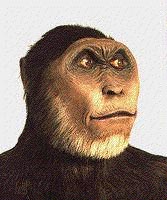 Some scientists such as George Karras feel the creatures are Hominid, such as
members of Australpithecus, who possessed long arms and walked on two legs.
Around 600 such skeletal remains have been uncovered in Sterkfontein Caves in
South Africa and dated to around 3.5 million years in age. Some scientists such as George Karras feel the creatures are Hominid, such as
members of Australpithecus, who possessed long arms and walked on two legs.
Around 600 such skeletal remains have been uncovered in Sterkfontein Caves in
South Africa and dated to around 3.5 million years in age.
Meanwhile, there are a few who have argued Bigfoot is a branch of Neanderthals,
who was supposedly exterminated by Cro-Magnon man such as Dr. Myra L. Shackley, a
professor of Archaeology at Leicester University who wrote "The Case for
Neanderthal Survival: Fact or Fiction?" published in Antiquity 56:31, 1982. Dr.
Fahrenbach is one who disagrees with this theory suggesting in a statement to
The Royal Forum, "The creature has no culture, tool use, fire, or compelling
evidence of abstract language, all characteristics that by definition are
required to be elevated into level of Homo, be it neanderthalensis or sapiens."
He went on to state, "rock throwing and pounding on logs are rather common among
Sasquatch." These traits are also shared by primates.
Later, Professor Sapunov told The Royal Forum, "The position confirmed by the
Academy of Sciences of USSR and its successor, The Russian Academy of Sciences
was following: Bigfoot is degenerative branch of late Neanderthal man, survived
to modern time. Its leadership include such well-known scientists as Professor
S.Obruchev, Professor K.Stanyukovich, Professor B.Porshnev."
Recent tests from the upper arm bone of a Neanderthal skeleton found in 1857
presented in a study of 378 base pairs of mitochondrial DNA showed 27
differences between modern man and Neanderthal DNA compared to the typical
variation of eight between modern humans. One difference is that Neanderthals
had larger brains.
Although there is no evidence in the fossil record, scientist presume
vocalization Neanderthals had a hyoid bone identical to humans, however air
pockets in their respiratory tract minimized their ability to vocalize.
Neanderthal noses were jutted outward and had large nasal cavities.
Their size was comparatively smaller than humans standing about 5 feet 3 inches
for females, with barrel chested torsos and short legs. Their physical strength
was greater due to their lifestyle of hunting and gathering. We cannot determine
their skin pigmentation or body covering (hair). Notably their feet also were
broader due to their stockier build. Their fingers were somewhat similar to Homo
sapiens with working thumbs.
In our search of evidence, we asked Eric Altman, "Do you think there is any
possibility they could be more intelligent than what we give them credit?"
Altman replied, "Researchers know very little about these animals and are just
now starting to understand a little bit about them through the evidence that has
been collected. Most of what we know is from witness reports and sightings."
Such a theory might hold weight in association with two Indian legends, which
geographically seem to validate the theory due to the sheer number of Sasquatch
sightings within these regions. We know from the BFRO reports the majority of
sighting occur in the Pacific Northwest in Northern California, Oregon, and
Washington, while the second pocket of sightings appear to occur in the
Ohio/Pennsylvania region. When you think of secluded places for something to
hide the forests of Northwest makes sense. However, when you have two close
neighboring states and one is mountainous and the other is largely farmland you
have to question why there are so many sightings in Ohio? The Royal Forum
presented this question to Eric Altman who stated, "There are a large number of
field researchers and organizations in Ohio." Meanwhile, Dr. Fahrenbach
elaborated, " Ohio has had an active group of Sasquatch researchers for a long
time, who presumably not only collect, research and follow up reports, but also
publish them. So you get a skewed impression of Sasquatch reports. Since I
suspect that there are about 5-10 unreported sightings for every reported one,
the true distribution might be quite different."
There are stories of two tribes of giants believed to have been eradicated by
Indians. These native legends seem to fit the profile with suggestive detail,
and geographic accuracy. In Northern California it has been suggested that the
Washoe and The Paiutes of Walker Lake region assisted in eradicating a tribe of
giants, described as hair covered and of lower intelligence, on the Eastern
slopes of the Sierra's.
Yet another Indian legend, reported by David Cusic, a Tuscorora by birth,
recalls that an ancient tribe of giants once existed in Ohio called the
Ronnongwetowanca, who had a considerable habitation. The Adena, known as the
mound builders, seem to have arrived in the Ohio Valley around 1,000 BC.
According to legend, after enduring attacks from the Ronnongwetowanca the Adena
banded together in a force of 800 killing off the Ronnongwetownca altogether.
The questions we pose for additional thought. Could this story have been carried
down nearly 2,000 years? How accurate would such an account be in time frame?
Dr. Fahrenbach told The Royal Forum, "Such oral traditions change in the course
of time and have at best some general suggestive content, but the details would
be dubious." What we know about these stories is that over time as they are
passed on details are either changed or forgotten altogether. Is it possible the
natives lost some important information in the story such as hair covered men
with ape like features? Would it be likely Indians would associate apes with
human like traits, calling them men altogether? Could some of the remnants of
this population have survived?
In 1846 Joseph Henry, first secretary of the Smithsonian Institution, estimated
there were ten thousand mounds constructed by the Adena in Ohio alone. These
mounds were constructed to bury the dead. Today less than 500 mounds exist in a
reconstructed form.
There appears to be little or no proof the following accounts took place,
besides what has been published in various news papers, magazines, and journals
over the years, however these accounts might warrant further archeological
investigation. It seems ironic that one of the largest complaints in science has
always been where is the scientific evidence? Yet, it might appear the most
conclusive proof has been uncovered, but not identified.
For if the account of the Ronnongwetownca has any truth behind the story there
might be a very real biological link to Sasquatch, which could perhaps be
identified through DNA or other related tests.
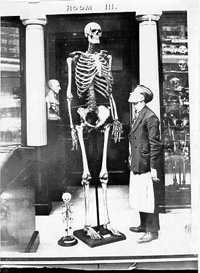 The Royal Forum discovered the following accounts, which appeared to validate
the legend, whereby human remains of massive proportion have been reportedly
unearthed. It is important to note that those doing the excavations where most
likely not scientists who would naturally identify the difference between a
Neanderthal like skull and a Homo sapien. In some cases papers have reported
these remains where sent to institutions, but have turned up missing.
Regardless, there appears to be no signs of significant proof many of the
following skeletal remains have actually been uncovered. Many might ask so why
report them? It is of our opinion to report facts and inspire ideas for study of
further examination. Quite simply what we have are many reports with little or
no supportive evidence the events took place. The Royal Forum discovered the following accounts, which appeared to validate
the legend, whereby human remains of massive proportion have been reportedly
unearthed. It is important to note that those doing the excavations where most
likely not scientists who would naturally identify the difference between a
Neanderthal like skull and a Homo sapien. In some cases papers have reported
these remains where sent to institutions, but have turned up missing.
Regardless, there appears to be no signs of significant proof many of the
following skeletal remains have actually been uncovered. Many might ask so why
report them? It is of our opinion to report facts and inspire ideas for study of
further examination. Quite simply what we have are many reports with little or
no supportive evidence the events took place.
In his book, The Natural and Aboriginal History of Tennessee, John Haywood wrote
in 1821 that a fortification containing skeletons at least seven feet in height
had been unearthed.
In 1829, a large skeleton was unearthed from a mound in Chesterville during the
construction of a hotel. The local examination of the skull stated the skull
could easily fit over a man's head. The skull also possessed an additional row
of teeth.
In Wisconsin, during the mid 1850s Dr. J.N. DeHart presumably found vertebrae of
what he classified as "larger than those of the present type."
In 1872, three skeletons were found in Seneca Township, Noble County, Ohio, in
what is now called 'Bates' Mound. All three skeletons were measured and found to
be over eight feet tall and proportional in bone structure. In addition, the
skeletons all had double rows of teeth.
Again another individual W.H.R. Lykins uncovered skull bones of large size in
mounds around Kansas City in 1877.
Later, in Ashtabula County, Ohio in 1878, more skeletons were excavated on land
belonging to Peleg Sweet. In the first mound, they unearthed a very large skull
and jaw. Excavating further, they discovered an estimated two and three thousand
graves disposed in straight rows. Some of the skeletal remains were reported to
of "large size" and blackened with time soon crumbled to dust.
The Indianapolis News reported Nov. 10, 1975 that a 9 foot, 8 inch skeleton was
excavated from a nearby mound in Berwerville, Indiana in 1879.
Meanwhile, another report in the St. Paul Pioneer Press, May 23rd 1883 reported
10 skeletons of gigantic size were removed from a mound. The remains included
both sexes.
In The History of Brown County, Ohio published in 1883, there is an account of
three skeletons reportedly found at the mouth of the Paw Paw Creek when men
digging for a bridge foundation found the bones at the lower end of old buffalo
wallow. When the skeletons were exposed to the weather for a few days, their
bones turned black and began to crumble. The Squire of Satterfield had them
buried in the Joliffe graveyard (Rivesville). All these skeletons found to be
about eight feet long.
The Scientific American, in 1883, published an article stating two miles from
Mandan, on the bluffs near the junction of the Hart and Missouri Rivers is 100
acre cemetery filled with bones of a giant race. The local paper, The Pioneer
stated the ground has the appearance of trenches piled full of dead bodies
covered with several feet of earth. In many places mounds were discovered to be
between 8 and 10 feet high. Some of them were 100 feet or more in length.
Again the St. Paul Pioneer Press reported June 29th, 1888 the discovery of seven
skeletons seven to eight feet tall in Minnesota.
Ironton Register, a small Ohio River town newspaper, dated 5 May 1892 stated
where Proctorville now stands a few mounds were found. One near the C. Wilgus
mansion contained a very large skeleton. The skull was found to have double rows
of teeth and was reported to again be of size to fit over a man's head.
Skeletons were found at a depth of 6 ft. and near a boulder stone pavement.
In the Chicago Record dated Oct. 24th, 1895 there was a another report by Ton G.
Dobbins that another mound near Toledo, Ohio harvested 20 skeletons with jaws
and teeth reported to be twice the size of normal dental features.
What we know about some of these reports is that remains were sent to various
institutions and subsequently disappeared. One such skeleton was reportedly on
display at Mark Twain museum in Virginia City, NV, and had a wisp of red hair
still attached. Indians have since repatriated it and has most likely been
reburied in some Indian graveyard in an unmarked grave.
Some scientists have discounted the remains are associated with Pituitary
Gigantism. The tallest man, Robert Wadlow, had Pituitary Gigantism and grew to
be an astonishing 8' 11 inches. Gigantism is an excessive secretion of growth
hormone during childhood before the closure of the bone growth plates, which
causes over growth of the long bones and very tall stature. The odds of having
the disease are 3 in 1 million.
If the newspaper accounts are ever found to have any basis of truth,
statistically archeologists would have to of unearthed at minimum millions
graves to account for this population. On the flip side, if these reports were
in fact hoaxes, numerous publications including journals and newspapers would
have to of been involved in either exaggerating accounts or printing information
in absence of a follow-up investigation. Under the analysis of these accounts,
The Royal Forum asked Dr. Fahrenbach about these reports. He replied, "I am
familiar with a variety of reports of giant skeletons found here and there, but
all that always seems to happen without the interaction of somebody who knows
exactly what to do with such material. I only hope that such material will get
into the right hands one of these days and is not shunted aside with a casual
comment about "tall Indians". In any case, It is always worthwhile to remain
cognizant of what might be waiting for a discoverer out there and be mentally
prepared to take appropriate action." Should this alone not warrant cause for
further investigation?
 Professor Porshnev of Russia along with Dr. Myra L. Shackley, Professor of
Archaelogy at Leiscester University believe pockets of Neanderthals might be
still thriving in Mongolia. A possible variant of Bigfoot, this grouping
considered the Almas, reside in the Altai Mountains along the Russian border of
Mongolia. The underlined difference is the apparent size of the Almas, which are
said to be approximately 5ft. in height. Some have suggested Almas could even be
Mesolithic hunters that have survived extinction. The Mesolithic people were
modern humans who were hunter/gathers after the Ice Age (between 8500 and 4000
BC). They possessed some physical variations such as flatter faces, prominent
cheek bones, and less prominent noses. Professor Porshnev of Russia along with Dr. Myra L. Shackley, Professor of
Archaelogy at Leiscester University believe pockets of Neanderthals might be
still thriving in Mongolia. A possible variant of Bigfoot, this grouping
considered the Almas, reside in the Altai Mountains along the Russian border of
Mongolia. The underlined difference is the apparent size of the Almas, which are
said to be approximately 5ft. in height. Some have suggested Almas could even be
Mesolithic hunters that have survived extinction. The Mesolithic people were
modern humans who were hunter/gathers after the Ice Age (between 8500 and 4000
BC). They possessed some physical variations such as flatter faces, prominent
cheek bones, and less prominent noses.
A report of an Alma being killed occurred in 1937, during a clash between the
Japanese and a Russian reconnaissance unit in Mongolia. The Russian unit spotted
two figures coming down a hill toward them and shot them when they did not
respond. The next morning the recon unit examined the bodies discovering they
were an unusual anthropoid ape about the size of a man and covered with long red
hair. Due to the war, the bodies could not be returned to Moscow for an
evaluation.
Perhaps the most important accounts ever involved Alma. It was discovered that
an Alma (known as Abnauayu by natives) was reportedly captured residing in an
village called T’khina lying on the Mokva River (Latitude 42º 51’ 50" N,
Longitude 41º 33’ 08"E) roughly 50 miles from Sokhumi (city of 112,000 people)
in the mid 1800s. The village lay in the Ochamchiri District of Abkhazia. Some
reports indicate the Alma captured later named Zana occurred on accident, while
others report she was captured by hunters. The ruling prince D.M.Achba, titular
head of the Zaadan region, came into possession of her. She was then passed onto
one of his vassals, named Chelokua. Ultimately he presented her to a nobleman,
Edgi Genaba, who visited the area. He then took her back to his village in
T'khina.
Villagers reported Zana as having black skin pigmentation, a reddish/black hair
covering her body. The hair on her head was thick and hung like a mane down her
back. She possessed a broad body structure, large hands, toes that would splay
outwards, high cheekbones, a flat nose, a muzzle jaw, and sloped forehead. From
reports we know she disliked clothing and preferred to be naked. She preferred
cold areas and sleeping outdoors and dug holes to sleep in. She reportedly
climbed trees to get fruit, cracked walnuts with her bare hands, and ate about
anything villagers prepared for her. Zana never learned the native language
(Abkhaz) and was aggressive during the first three years.
Zana was witnessed spending a considerable amount of time cooling off in pools
beside buffalo and at night used to roam the hills surrounding the village. In
reports she wielded large sticks against dogs and had a curious obsession for
playing with stones, knocking one against another and splitting them. It was
reported she took swims year round, and preferred to be naked even in winter,
tearing dresses.
Edgi Genaba taught Zana to grind grain for flour, bring home firewood and water,
or sacks to and from the local water-mill, and even pull boots off.
The credibility of this report demands attention for several reasons. First,
scientist have discovered fossil evidence of both Neanderthal and Homo Erectus
residing in the area where Zana lived. Secondly, Zana possessed almost all
identical traits to Neanderthals. Third, the geography of the region (Georgia)
is mountainous and sparsely populated, especially along the edges of the Russian
border.
Those who remembered Zana reported Edgi Genaba kept her in an enclosure
approximately three years with little human contact. Reports indicated she was
thrown food and dug holes to sleep in. Eventually she grew calm around humans
and was given freedom to roam the countryside. It is reported she enjoyed wine
and became pregnant six times by different men of the village. Only four of the
offspring survived with the help of the village. The children apparently had
modestly different physical features and grew up as fully functional living in
the village. The children where Dzhanda (born in1878), Kodzhanar (born 1880),
Gamasa Sabekia (born 1882), and Khwit Sabekia (unkown). Her offspring are now
scattered throughout the region. Zana died in the late 1800s.
For a successful crossbreeding to occur the chromosomes in place must match each
other. If one species has recessive genes then the traits may show up in the
offspring or skip generations. If in fact, Zana was a Neanderthal her traits
were then recessive and therefore did not pass to her children. Science has
concluded in most cases of interspecies mating the offspring become sterile or
cannot reproduce. This is a statistical probability, yet there are some recorded
instances of reproduction in hybrids among primates.
Many scientists consider Neanderthal a sub-species of man, thus the name Homo
sapiens neanderthalensis. This can explain how Zana’s children reproduced. The
chances of a successful hybrid between these would be significantly better than
between different species altogether.
Both her sons, Gamasa and Khwit were both powerfully built and possessed dark
pigmented skin. Villagers reported that Khwit was difficult to deal with and
quick to pick a fight.
In 1954, Professor Boris Porshnev of the Soviet Union visited the mountainous
region interviewing a grandson of Zana. A while later, Dr. Myra Shackley also
went to the Altai Mountains to look for evidence. Porshnev reported the grandson
possessed dark skin and was able to lift up a chair with a grown man resting in
it with his jaw. They found bones believed to belong to Gamasa in October 1965
reporting slight paleoanthropic features and decided to exhume the clearly
marked grave of Khwit, Zana's younger son.
Two physical anthropologists, M.A.Kolodieva and M.M.Gerasimova, reported in 1987
the skull features were found to be unusually similar to Neanderthal and
Cro-Magnon man stating:
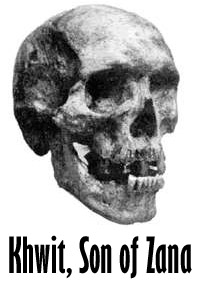 "The Tkhina skull exhibits an original combination of modem and ancient features
... The facial section of the skull is significantly larger in comparison with
the mean Abkhaz type ... All the measurements and indices of the superciliary
cranial contour are greater not only than those of the mean Abkhaz series, but
also than those of maximum size of some fossil skulls studied (or rather were
comparable with the latter). The Tkhina skull approaches closest the Neolithic
Vovnigi II skulls of the fossil series..." "The Tkhina skull exhibits an original combination of modem and ancient features
... The facial section of the skull is significantly larger in comparison with
the mean Abkhaz type ... All the measurements and indices of the superciliary
cranial contour are greater not only than those of the mean Abkhaz series, but
also than those of maximum size of some fossil skulls studied (or rather were
comparable with the latter). The Tkhina skull approaches closest the Neolithic
Vovnigi II skulls of the fossil series..."
Skeptics to the account have suggested Zana might have been a human displaying a
single or rare combination of two diseases. One is a mutation lacking the gene
responsible for producing myostatin, a naturally occurring protein that blocks
muscle growth, muscle mass can grow extremely large resulting in a stocky build.
Another possibility considered was a disease called hypertrichosis, which causes
excessive hair growth on the body. Various people have suffered from this
disease have been reported to look like "dogmen" or "apemen". However to have
these features alone doesn't explain her behavior or Zana's facial features.
The Royal Forum learned Professor Sapunov examined the skulls of Zana's children
ruling the skulls where within Homo sapien tolerances. We questioned whether
Russia had considered running DNA tests on the remains to determine if there is
perhaps a relationship. Dr. Sapunov responded, " I tried to make DNA analysis of
wildman hairs from Pamir in laboratiry of the Petersburg Medical Institute of
Hynecology, but failed, because hair root containing DNA was absent."
Another report describing a possible capture occurred in British Columbia. The
Colonist Newspaper reported the British Columbia Express Company had sent a
regular train from Lytton and in the vicinity of No. 4 tunnel some twenty miles
North of Yale, B.C. on July 2nd, 1882 claimed to have brought the train to a
stop and captured a hairy ape with human traits, later named Jacko. They
described the animal as being a gorilla type standing 4,7" weighting 127 lbs.
The animal was first seen lying in the vicinity of the tracks by the conductor
who feared it was a man. He applied brakes to the train and sounded the horn.
When the horn sounded, the Sasquatch bolted up a steep bluff and became trapped
on a ledge. After being pelted with a rock the animal was apparently knocked
unconscious.
A couple of noteworthy descriptions are evident in the article including a
mention the forearms were longer than man's. The ape like creature had a face
liked a man with black hair all over, and possessed tremendous strength.
Likewise the report mentioned the animal ate berries and drank milk.
A Mr. George Telbury, from Yale, B.C., is mentioned as animals keeper. In the
newspaper article he reported a plan to leave for London, England, to exhibit
him.
 This report was originally traced by legendary researcher John Green, who has
tracked Bigfoot reports for almost half a century in British Columbia. What we
know is the newspaper shortly afterward moved to another town and there was no
follow-up on the story. Mr. Green interviewed someone who claimed to be aware of
the animal at the time, although he never saw it in person. Some people have
said the animal went to a Barnum Baily act and subsequently died and was
replaced by a human Wildman. Meanwhile, others have speculated this was a trick
by the newspaper to increase sales This report was originally traced by legendary researcher John Green, who has
tracked Bigfoot reports for almost half a century in British Columbia. What we
know is the newspaper shortly afterward moved to another town and there was no
follow-up on the story. Mr. Green interviewed someone who claimed to be aware of
the animal at the time, although he never saw it in person. Some people have
said the animal went to a Barnum Baily act and subsequently died and was
replaced by a human Wildman. Meanwhile, others have speculated this was a trick
by the newspaper to increase sales
There is a considerable debate over how Sasquatch should eventually be studied
and eventually brought to science. Dr. Fahrenbach suggested to The Royal Forum,
"Remote cameras deployed in promising locations either have captured nothing or
have been deliberately dismantled (not by human intervention). At present the
most promising approach is that of habituation, as has been so successful in
Africa with great apes. This requires residence in rather wild country, that
gets approached spontaneously by one or more Sasquatches." He went on to suggest
a person who is unintrusive and will not panic. The person should be a specific
observer, preferable female, who has the guts to expose herself to their
approach and provide them with food on a regular basis, and lastly, such a
person who has the patience, leisure, and monetary support to see through such
an experiment over a matter of many months or possibly years. This combination,
along with a desirable level of education, is difficult to find in the preferred
habitat of Sasquatch and remains extremely rare, though not unknown."
Meanwhile, others such as Todd Neiss have attempted to use biopsy darts, which
featured an oversized hollow needle filled with microscopic barbs fired using a
blank from a 22. Caliber rifle. At a range of 75 ft. the barb could hit the
subject and then fallout presenting a tissue sample for DNA analysis. However,
Neiss himself concludes the likelihood of coming this close to an animal is very
unlikely. He went on to state that shooting just one might be the best scenario.
Yet he admits the most likely scenario will probably be when one is hit by a
logging truck or car.
There is a variety of new technology being deployed in field research. However,
the future aim of this area study might involve enhanced applications of
coverage to detect and locate these animals, such as Seismic listening devices
to detect under ground cavities or cave networks that could be hidden. High tech
surveillance equipment like those used in security applications may find a home
in field research. For example, pan tilt cameras could prove effective in
research with a 23 times optical zoom multiplied by another 10 times digital
zoom by providing enhanced clarity in low light conditions over vast distances.
Pan tilt cameras could be fixed to trees or poles to cover wide areas such as
open meadows and could be wired back to fiber transmit/receive modules shooting
video through a fiber backbone over long distances back to a digital video
recorder. This could provide motion alarm notification and the ability to search
for motion by controlling size, speed, and direction of motion scientists are
looking to find. Likewise, a series of wireless motion detectors could be
deployed featuring small animal immunity filters used in conjunction with wide
series of repeaters to reach broad distances. Again this could be hardwired back
into a digital video recorder turning pan tilt cameras in the direction of an
alarmed event such as motion.
The future of this study in this subject might also involve the use
Photoelectric Beam Sensors to detect movement in certain areas. They can cover
long distances triggering alarm when only multiple beams are broken at a certain
heights.
 Another field technique could be deployed for DNA analysis of saliva along with
finger print identification by placing cookies, candy bars, or hamburgers in a
large cup and covering the cup with a greasy microwave popcorn. By hiding it in
a trash can with a large rock on top researchers hope to have a Sasquatch handle
the greasy popcorn bag, then handle the cup. This technique has been deployed
with success in Chickasaw National Park, OK by researcher Charles Hallmark. Another field technique could be deployed for DNA analysis of saliva along with
finger print identification by placing cookies, candy bars, or hamburgers in a
large cup and covering the cup with a greasy microwave popcorn. By hiding it in
a trash can with a large rock on top researchers hope to have a Sasquatch handle
the greasy popcorn bag, then handle the cup. This technique has been deployed
with success in Chickasaw National Park, OK by researcher Charles Hallmark.
In light of the research, we have to question several prominent philosophical
questions. Is it morally right to kill a rare species to bring a specimen to
science? What if this species turns out to be a human variant? Would Bigfoot
then fall under the same Constitutional Rights as we do? For the Constitution
states all men are created equal. At what point do we draw the line between man
and animal? Likewise, could someone be tried for murder if they shot a human sub
species? Legal protection is not far off as Florida almost passed into law a
bill protecting Skunk Apes in the state. A Criminal Justice Committee in Florida
passed a bill (HB58) two consecutive years in Florida making it illegal to
molest a Skunk Ape, however the bill never made it to the floor.
This presents, yet other questions. White man wiped out entire populations of
Native Americans with disease such as small pox, chicken pox, and more. What
diseases can Sasquatch be susceptible to transmission from human presence?
Todd Neiss stated a fundamental concern many face by mentioning, "My big concern
is we are dealing with something I fear is going the way of the Passenger Pigeon
or Do-Do birds. Nearly as the Condor and American Eagle fell into the same
demise. Just ignorance. Just sheer ignorance. Let's put our heads in the sand
and they will be fine and then behold they are gone. "
"I don't want that to happen. I want my grandchildren and my great grandchildren
to have the opportunity to not only know these things exist, but be actually
able to see them in one format or another. They need to be brought to their due
place in the scientific community. They are an integral part of biology here for
sure, and we need to know what role do they play, how do they interact, and what
resources do they require?"
"We need to ensure those resources and habitat are there. I fear the day will
come that these little pockets of these clans, if you will, are going to be so
isolated that their gene pool is going to be to small to sustain the population.
I would like to see these animals officially recognized. The sooner the better."
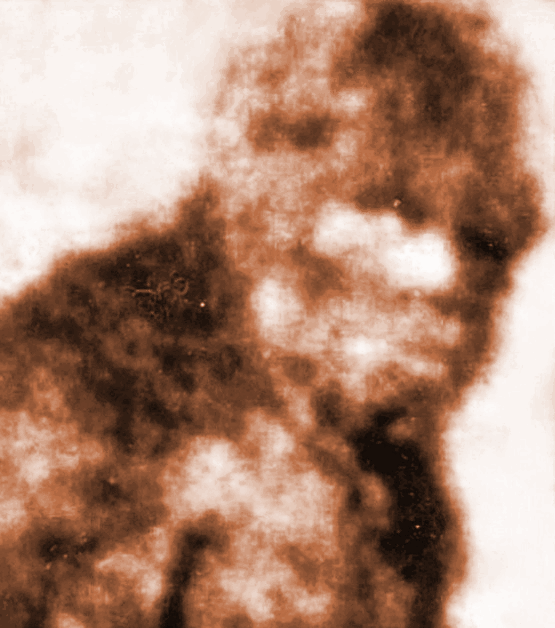
*Article used with
permission of Author, Bryan Beets.
The photos appear here under the fair use
for educational purposes of copyright material.
.jpg) |